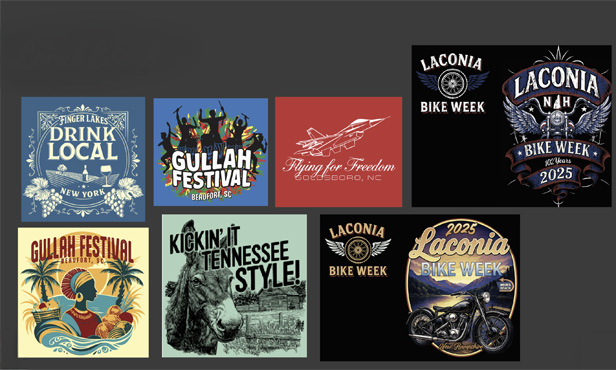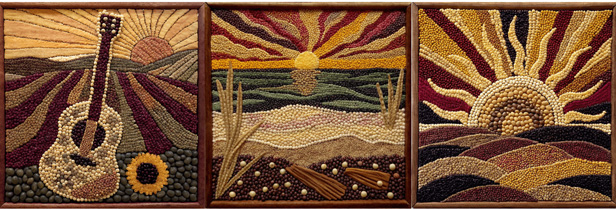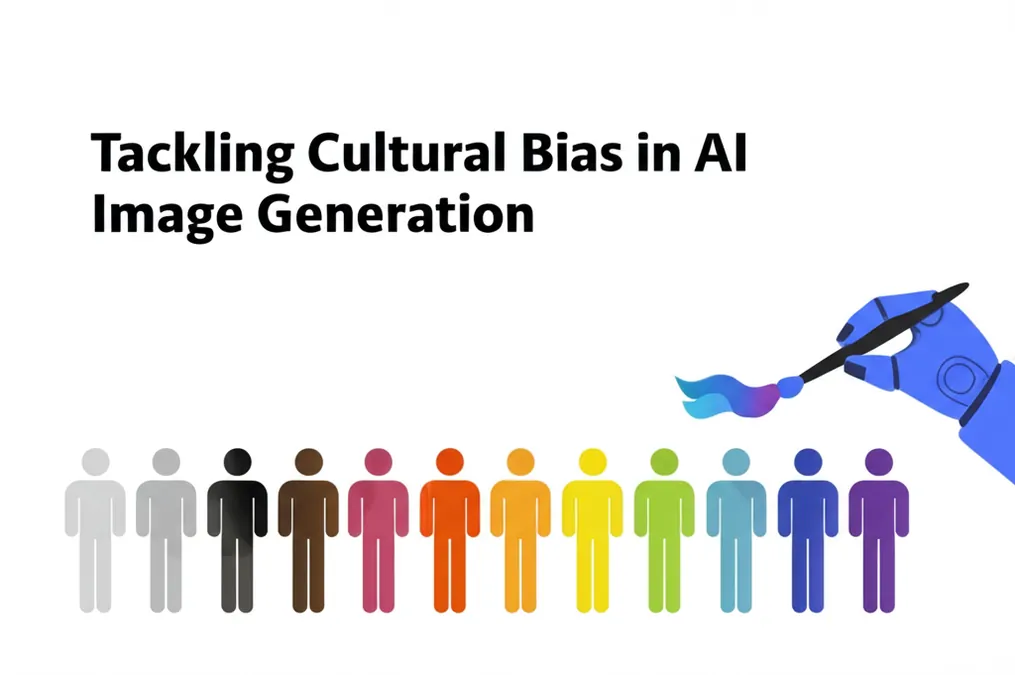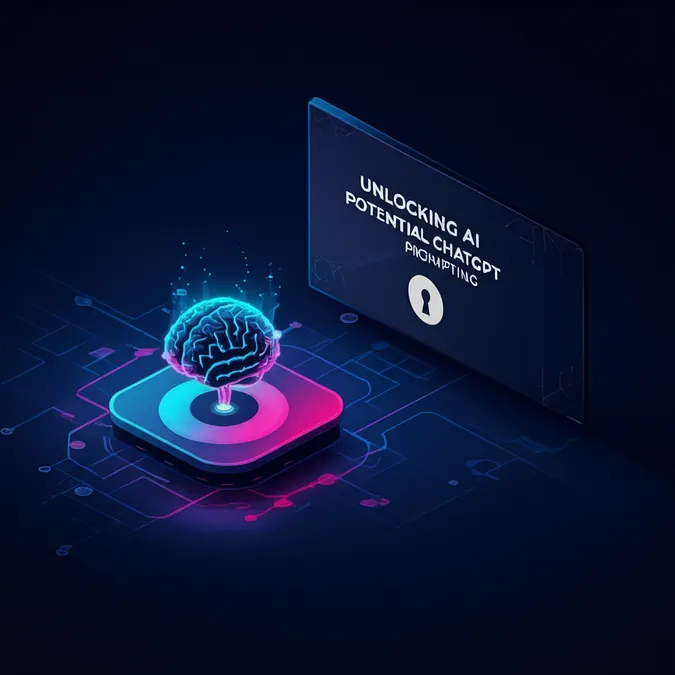Developer Offer
Try ImaginePro API with 50 Free Credits
Build and ship AI-powered visuals with Midjourney, Flux, and more — free credits refresh every month.
AI Art The New Frontier for Designers
Glowing geometric puzzle pieces fit together perfectly behind company logos. Moss-green Floridian foliage is the backdrop for swooping letters advertising a family festival. A grinning raccoon palms a frothy beer next to a witty catchphrase.
Few people would guess these graphics were created with the help of generative AI.
Decorated apparel industry veteran Marshall Atkinson used Midjourney, an AI image model, to create the foundation for these designs. He says AI-generated artwork cuts down his design time and can replace up to 80% of the creative process.
“Why would I spend three hours doing something when I can spend 20 minutes?” he asks.

While Atkinson still manually adds elements like text and company-specific logos, he is part of a growing movement of designers using AI to streamline their creative workflow.
The Rise of AI in Promo Design
According to the 2025 State of the Industry report, the adoption of AI is well underway, with 24% of suppliers and 19% of distributors using it for artwork or video generation. For suppliers, it’s the second-most common use for the technology, and for distributors, it's the third.
Proponents argue that generative AI is a powerful tool for saving time and money, especially for smaller companies. However, others in the industry urge caution, pointing to copyright concerns and the technology's current limitations. “I honestly think the best way [industry professionals] can use AI is not to use it for art generation,” says veteran embroidery digitizer and designer Erich Campbell. “There’s a lot of uses that don’t have to impinge on the one creative thing we’re doing that could still be quite helpful.”
Boosting Creativity and Productivity
One of the most significant benefits of AI in art creation is the sheer speed of iteration. Freelance artist Michelle Moxley recently used AI to create 60 T-shirt graphics in just two days. Comparatively, using traditional clip art, she could produce three to five graphics a day; with hand-drawn sketches, that number drops to one to three.
“AI enables me to provide a greater variety of options and refresh them more frequently, which increases overall value,” she adds. Moxley clarifies that she uses AI as a “custom clip art machine,” generating various graphics and then combining pieces in a collage style rather than using a single generated image as the final product.

Beyond volume, properly trained AI models can handle complex tasks with incredible speed. Moxley trained a model to replicate seed art, an intricate mosaic-style technique. “You can make a piece of seed art, but can you make 25?” she says. “That would take me two years. This took me, once I trained it, 20 minutes.”

AI tools are also making their way into print-on-demand production. Supplier Unionwear worked with the New Jersey Institute of Technology to develop an AI-powered pattern generator for its tote bags, allowing customers to choose, edit, or create unique designs from scratch.
Where AI Art Falls Short
In recent years, AI models like Midjourney and OpenAI’s Dall-E have become increasingly sophisticated. As noted by the Interactive Design Foundation, neural network algorithms allow them to learn from vast datasets to generate more realistic artwork.
However, AI still struggles with details like spelling and replicating fonts. Moxley’s podcast, Fahrenheit AI, was named because only one AI image generator could spell “Fahrenheit” correctly. Atkinson also notes that he never relies on AI for text.
In the embroidery sector, AI-generated artwork is not yet a major factor. Campbell explains that while some companies advertise “AI-powered digitizing,” it’s often just a new buzzword for the same auto-digitizing processes that have existed for years. AI images meant to mimic embroidery often feature impossibly small stitches that are unrealistic to reproduce with thread. “We still don’t have an automatic way to take a piece of art you give us and spit out good-quality embroidery,” Campbell says.
Furthermore, AI is not a suitable replacement for high-stakes logo design, says Vladimir Gendelman, CEO of Company Folders. “When you design a logo, you have to consider emotional aspects, the human touch points,” he states. “AI doesn’t do that.”
The Ethical Maze of AI Creation
The conversation around AI art is fraught with ethical concerns. A recent Vogue ad for Guess featured a model confirmed to be AI-generated, sparking criticism for promoting unattainable beauty standards and taking work from human models and photographers.
Designers are already feeling the impact. “All my friends who are digital artists, people who live on commissions, are suffering,” Campbell says, noting that while opportunities for highly skilled craftspeople will remain, many mid-level jobs may disappear.
Another major criticism is the technology's high environmental cost. Generating AI images requires significant energy. According to an article in MIT Technology Review, experts speculate that by 2028, AI could consume as much electricity annually as 22% of all U.S. households.
Copyright infringement is another battleground, with dozens of lawsuits filed by creators and companies like The New York Times who argue that AI models are illegally trained on their protected work. This has led some designers, like Moxley, to be transparent about their AI use. “Do I think that AI is stealing? Yeah, I do,” she admits.
“People were ripping off Mickey Mouse long before AI. When photography started, all the portrait painters suddenly said, ‘Art is dead.’ Did art die because photography was invented? No. Is art going to die because AI was invented? No.” – Marshall Atkinson
Atkinson, who runs a newsletter guiding creatives through AI, sees it as a tool, not a replacement for human creativity. He argues that an AI learning from data is no different than an art student studying masterpieces in a museum. He emphasizes that he always adds his own touch to designs, treating AI as a starting point, not the final product.
Compare Plans & Pricing
Find the plan that matches your workload and unlock full access to ImaginePro.
| Plan | Price | Highlights |
|---|---|---|
| Standard | $8 / month |
|
| Premium | $20 / month |
|
Need custom terms? Talk to us to tailor credits, rate limits, or deployment options.
View All Pricing Details

